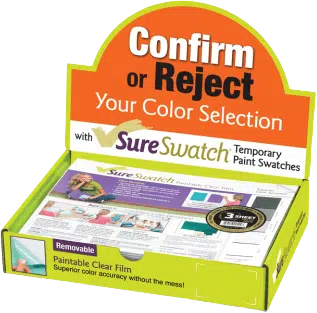Maybe you have used paint samples before or maybe this is your first time. Either way, we know you might have some questions. We have put together our most frequently asked questions about our SureSwatch® product.
Frequently Asked Questions
Learn How SureSwatch Can Help In Your Next Paint Project
Our Most Frequently Asked Questions About Our SureSwatch® Paint Samples.
Paint is like a film; the surface on which you are painting can affect the color you are trying to achieve through color matching.
So unless you are painting directly on a white wall it is best not to use a white material for your test surface. The white material might give you a false positive.
This means you might like the color you tried on the white material, but when you go to paint your wall the color will be different.
SureSwatch should dry in 20 – 60 minutes. Humidity and temperature could play an effect on this drying time. Make sure it is dry to the touch. Also, make sure there are no shiny or wet spots visible. Painting a color sample is easy with a SureSwatch.
One of the easiest ways to know if you have a bright, vibrant color is to place the Primer Decider Scale under your painted SureSwatch. If the coverage can be improved with the use of a primer then you have a bright, vibrant color.
SureSwatch is a durable material that should not rip. The best way to remove is to gently lift a corner and peel in a diagonal motion.
SureSwatch paint swatches are paintable with any kind of sheen, color paint, or paint brand.
Be sure not to apply SureSwatch to wallpaper, unpainted drywall, or recently painted walls. The adhesive could cause damage to these types of substrates. It is suggested to remove SureSwatch within 14 days of application. As with most painting projects it is best to start with a clean, dry, and non-flaking surface.
Paints of all colors reflect different amounts of light. It’s easy to see that dark colors like deep blue reflect less light while bright colors like lemon yellow reflect more light.
The same holds for gray primers; dark gray primers reflect less light while light gray and white primers reflect more light. If the amount of light reflected by a topcoat color is matched by a gray primer, the eye perceives improved coverage of the topcoat.
For example, deep blues look better over dark gray primers while bright yellows look best over light gray or white primers. The Primer Decider makes it easy to pick the right shade of gray primer for your specific topcoat color.
The old trick is to take fingernail polish on a cloth and lightly rub it in an inconspicuous test area. If it is latex, the paint will soften and can be easily removed. If the paint does not seem to be affected by the test, it is typically an alkyd coating.
With today’s technology, it should generally not be a problem. However, if it is an oil-based paint, extra attention should be taken to remove the glossy sheen and remove all surface dirt. And finally, it is important to prime the surface with the appropriate primer to endure maximum adhesion.
Typically, if you are looking for a smoother finish a synthetic brush is best and if you would like more texture, use a natural bristle brush. If you are using latex paint, nylon or synthetic brushes are recommended while natural China bristles are recommended for oil-based paints.
If you don’t see your question listed in our frequently asked questions, contact us today and we may update this page with your question!

